How to reach here:
By Air:The closest domestic airport to Dwarka is located at Jamnagar, which is about 137 km away. There are regular flights from Jamnagar to Mumbai International Airport.
By Rail: Dwarka railway station in the Ahmedabad - Okha rail route is connected to other major railway stations. Tourists can take trains from Ahmedabad (Gorakhpur Exp), Delhi (Uttaranchal Exp), Mumbai (Saurashtra Mail), Kolkata (Okha Howrah Exp) and Bangalore (Vivek Express)
Best time to visit: October to June
Languages spoken: Gujarati, Hindi.
Must eat: Pooda, Khichdi,Fansi nu Shaak,Methi na Gota,Lasaniya mamra,Ladu, ladwa.
Famous Restaurants: Drool Kitchen, Chappan Bhog multicuisine Restaurant, Meera, Radhika.
Places you must visit:
Gita Mandir is situated towards the Western Ghats of Dwarka. This temple was built by the industrialist family of Birlas in 1970. The temple is constructed using marble, which adds to the beauty of the temple. This shrine was built to protect the rich scripture, teachings and values of the religious book of Hindus, the 'Bhagavad Gita'.Besides, the walls of the temple are carved with the hymns of Bhagavad Gita. Along with this, the temple ceiling is designed is a special way so that every voice heard in the hall is echoed.

Dwarka Lighthouse was constructed at Rupen Creek during the early 19th century. In order to lift a lamp, a flag mast was posted at the port, which thereafter served as a lighthouse. In 1866, eighteen meters tall square tower was constructed at this site, along with an installation of an oil wick lamp.The present day tower measures around 43 meters in height and was constructed between 1960 and 1962. On 15th July 1962, this lighthouse was inaugurated by the then transport minister Mr. Raj Bahadur. In addition to the tower, a RCC Baffle wall was constructed at the site for installing the sound horn equipment and vibrators that can work as fog signals. In 1988, this fog signal service was terminated.Further, on 15th April 1964, this lighthouse was commissioned with other advanced facilities. From this lighthouse, travelers can see the panoramic sight of sunset.

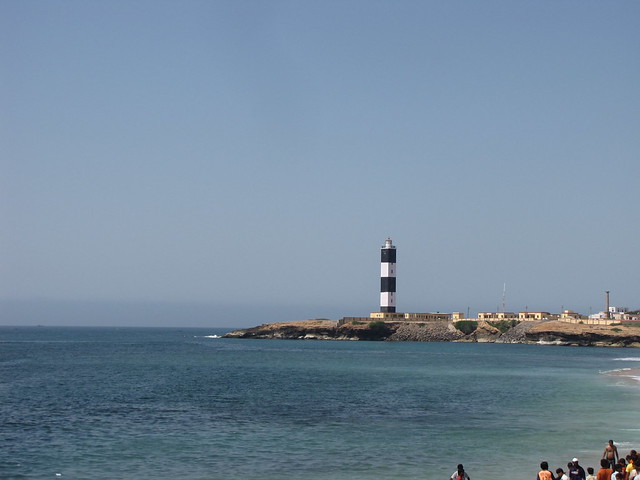

Beyt Dwarka is an island, situated at a distance of 30 km from the main town. This island is surrounded by few temples, white beach and coral reefs. The main temple at Beyt Dwarka is that of Lord Krishna, which is believed to be located at a site that was once the residence of Lord Krishna and His family. This temple is over 500 years old and was built by Sri Vallabhacharya. Beyt Dwarka features temples of Vishnu, Radha, Lakshmi, Satyabhama, Devaki and Jambavati. There is a narrow street which leads to these temples that are crowded by vendors selling local crafts, idols, cassettes, coconut and seashells.This island is also known as Beyt Shankhodhar, which was one of the main ports of the town, before the development of Okha. The beach is popular among travelers for its rich marine life, marine excursions, water sports, camping and picnics.


Rukshamanee Mandir is dedicated to the beloved wife of Lord Krishna, Devi Rukmani. Among all His 16,108 wives, Devi Rukmani was Lord Krishna’s favourite. The Rukshamanee Mandir, which is also known as Rukmani Temple, features varied paintings of the 12th century on its walls. These paintings capture the time spent by Lord Krishna and Devi Rukmani.It is located on the banks of Bhagirathi River, which can be seen while travelling to Beyt Dwarka. The Mandir comprises a beautiful marble deity of Devi Rukmani, with four hands or Chaturbhuja. These four hands hold Shanka, Chakra, Gada and Padma, which symbolise her being reincarnation of Goddess Maha Lakshmi.Due to the curse spelled by Rishi Durvasa to Devi Rukmani, this Rukshamanee Mandir is placed away from the main Dwarkadish Temple in the town.

Dwarkadhish Temple, popularly known as the Jagat Temple, was built in the 16th century. The original Dwarkadhish Temple was built by the great grandson of Lord Krishna, King Vajranabha. It is a 5 storied temple constructed using sand and limestone. This temple is located in the middle of the town, with a 70.5 meters high spire.On the top of the temple dome, there is a 24 meters long multicolored flag, with symbols of moon and sun on it. The temple has a platform area of 1800 sq. feet and comprises a shrine, which is well supported by 60 pillars. These pillars are made of sandstone and granite, which render extra strength to the shrine.Tourists have to climb around 56 steps, representing the 52 administrative divisions of the Yadava kingdom and remaining four represents Krishna, Balaram, Pradyuman and Anirudhha, respectively. This Jagat Mandir has two main entrances, one facing north and another facing the south. The north entrance, which is also the main entrance to the temple, is known as the 'Moksha Dwara' (Door to Salvation). This entrance also leads towards the town market near the temple.The south entrance of the temple is known as the 'Swarga Dwara' (Gate to Heaven). This entrance opens towards the Gomati River, where devotees are required to take a bath before entering the temple. The main deity in the temple is Lord Dwarkadhish or Lord Krishna. There is also a statue of four-armed Vishnu known as Trivikrama.In addition to the main deity, there are various shrines dedicated to different deities, like Balarama, Devki, Vasudeva, Rukmani Devi, Satyabhama Devi and Jambavati. The temple also comprises shrines of Lakshmi-Narayan and Saraswati. Non-Hindus can also enter the temple after filling a form stating that they believe in the Hindu religion.


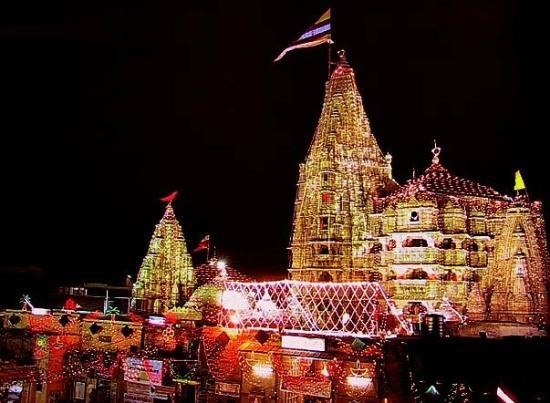

Gomati Sangam Ghat is the sacred place where Gomati River flows. This ghat can be reached by climbing down 56 steps from the Swarga Dwar of the Dwarkadish Temple. The Gomati River, which is also known as the descended Ganges, meets the sea at the Chakratirtha Ghat.The Chakratirtha Ghat is famous for a wheel with white porous type stones, called as Dwarkashila or Chakrankitha. There are over 12 ghats surrounding the Gomati River, which are venues of Samudra Narayana Temple, Gomatiji Temple, the Panchanada and Chakra Narayana. The point where the Gomati River meets the ocean is known as the Gomati Sangam.On the river banks of Gomati, there is a holy Gomati Kund, where Rishi Durvasa was served by Lord Krishna. At this Gomati Kund, the Gomati River merges with the Arabian Sea and it is considered sacred to take bath here.Gomati Ghat features many temples including Shiva Temple and other smaller shrines of Lord Krishna and his friend Sudama.


Samudra Narayana Temple is situated at the Gomati Sangam Ghat, which is at the back of the main Dwarkadish Temple. The deity in the Samudra Narayana Temple is goddess Gomati, who is believed to be brought from heaven by Rishi Vasistha. This temple is surrounded by Panchanada Tirtha, which comprises 5 wells that have sweet water.There is also a Chakra Narayana Temple nearby the Samudra Narayana Temple, which features a stone marked with a chakra that manifests Lord Vishnu. This temple is very close to the confluence of Gomati River and Arabian Sea. The main idols enshrined in the temple are that of Samudra Deva, Lord Varuna, Mother Astha Bhavani and Mira Bai. There is a sacred kund or tank in the temple, where several ceremonial sacrifices are performed. This temple is also located close to a meditation cave, Manoratha Dwar, where saints are seen engrossed in meditation.


Nageshwara Jyotirlinga Temple, also called the Nagnath temple, is located in the outskirts of Dwarka, in Gujarat. It is a famous Lord Shiva Shrine in India, which is situated between Gomati Dwarka and Beyt Dwarka Island. Nageshwara is one of 12 Jyotirlingas mentioned in the Shiva Purana.The lingam enshrined in this temple is that of Nageshwara Mahadev, symbolising protection from all kinds of poison. The highlight of the temple is the Nageshwara Mahadev Shiva Lingam, which is a giant statue.This temple is unique in the sense that the Shiva Lingam faces to the south and the Gomugam faces towards the east. According to the Shiva Purana, Lord Shiva started residing in the temple after he killed a demon named Daaruka. This place was thus named after this demon as Darukavana.
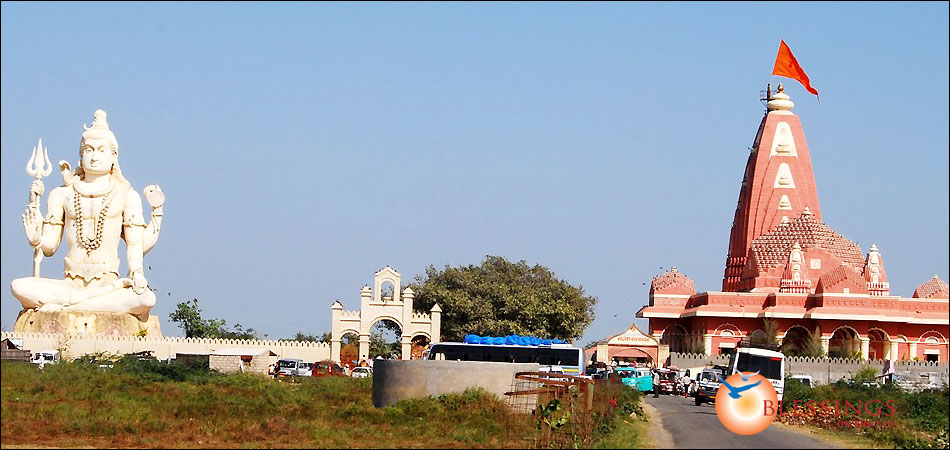


Shardha Peeth is the first Peeth among the four Peeths established by Adi Shankaracharya. Other Peeths founded by Adi Shankaracharya are at Sringeri, Puri and Jyotirmath. The Shardha Peeth is over 250 years old and is visited every year by thousands of pilgrims from across India.Adi Shankaracharya found this Peeth in 491 AD for withholding the traditions of India. This Peeth is also known by various names like Kalika Matha, which is in charge of the Sama Veda, the Paschimamnaya Matha and the Western Matha.The Shardha Peeth operates a museum, Shardha Vidhyapeeth Art College and an Indian Research Temple. This Peeth is an ideal learning centre for students who want to acquire knowledge about Indian Culture and Archaeology. The entire research work in the Peeth is carried out in Sanskrit language. This Peeth is managed by Swami Swaroopananda Saraswati, who also heads the Northern Matha at Jyotirmath.
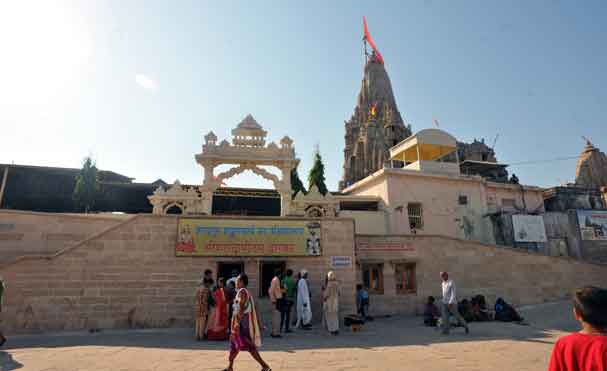
Dunny Point is situated at Beyt Dwarka, embraced by sea and coral islands. This is the first eco-tourism site in Gujarat, which is ideal for swimming and sunbathing. The site also features a wide variety of marine life, including dolphins, turtles, fishes and dugongs. Tourists indulge in several activities like bird watching, water polo, kite flying, meditation and cruise vacations.


Gopi Talav or the Gopi Tank is a small pond surrounded by sandal like yellow sand, known as Gopi Chandan. This Chandan is used by devotees of Lord Krishna to make tilak marks on their bodies. The Talav has a special significance in the Hindu mythology, as it is believed to be the place where gopis came to see Lord Krishna in Dwarka.It is believed that Lord Krishna killed a demon named Bhaumasura and freed 16,000 princesses from his palace at this site. This site got its name as Gopi Talav after the Gopi princesses, who fell in love with Lord Krishna and wanted to marry him.
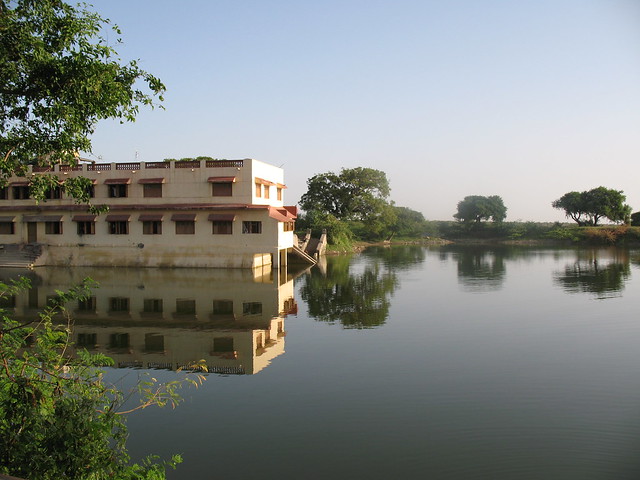
Hanuman Dandi Temple has been built at the place where Hanuman and his son Makardhwaj met. The Hanuman Dandi Temple is the only temple in the whole India which has idols of Hanuman and his son Makardhwaj. Devotees coming to this temple take back home a supari (beetle nut) and when their wishes get fulfilled; they bring back the same supari, plated with gold.
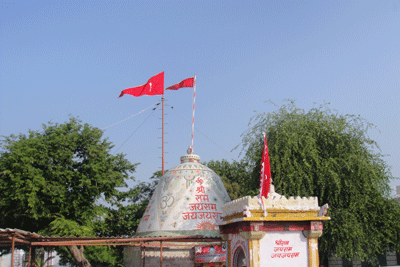
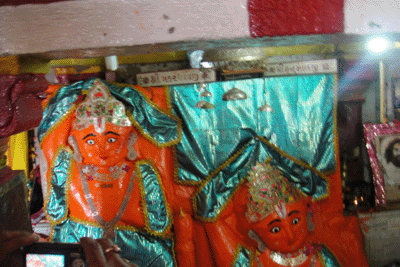
Rukmini Hrid, which features seven ponds, is one of the popular tourist attractions in Dwarka. These seven ponds are collectively known as the Rukmini Hrid. According to the Hindu Mythology, this place washes away all human sins and bestows salvation on mankind.It is also believed that taking a dip at Rukmini Hrid can help in attaining Moksha or freedom from the cycle of rebirth. Rukmini Hrid is commonly known as Bhrigu Theertha, as Rishi Bhrigu is associated with this place.
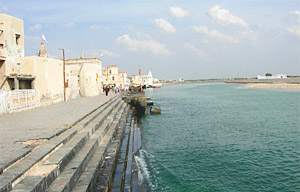
Brahma Kund which is located just few kilometres from the town is famous for bathing. Local residents believe that the nectar from this kund got mixed with the sacred water of river Ganges, which consequently turned the water sweet.Lord Krishna came to Dwarka after bringing the sinners to the path of virtuosity. During that time, Indra, Yama, Sun, Moon, Kuber and Varuna came to greet Lord Krishna on His accomplishment. Soon after this, Lord Krishna created a pilgrimage site at this place which came to be known as Brahma Theertha or the Brahma Kund. This Brahma Kund is believed to free human beings from all their sins.

Panch Kuai, also known as the Panchard or five rivers, is venue of a popular Lakshmi-Narayan Temple, who is the main deity of the place. The Panchard Temple also features idols of Lord Krishna, Durvasa, Hanuman and Goddess Ambaji.This site boasts footprints of Pandavas, Charan Padooka, footprints of some powerful sages and Bhajan Caves.
Sindhu Sadan lies in the ancient city of Dwarka, which also houses several other popular temples. The building of this sacred site was built by Shree Purushotam Vikram Mavajee in 1906. He was known as the jewel of Okha Mandal and constructed this building for his residential purpose.Sindhu Sadan features a nearby Sunset Point, from where tourists can get a beautiful view of sunset.
No comments:
Post a Comment